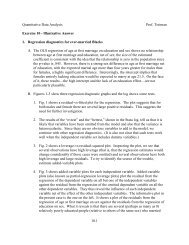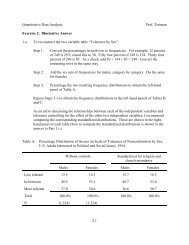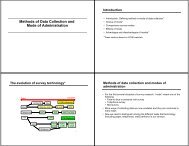Notes on Poisson Regression and Some Extensions
Notes on Poisson Regression and Some Extensions
Notes on Poisson Regression and Some Extensions
Create successful ePaper yourself
Turn your PDF publications into a flip-book with our unique Google optimized e-Paper software.
Proporti<strong>on</strong>0 .1 .2 .30 2 4 6 8Number of Childrenmean = 1.939; overdispersi<strong>on</strong> = .2417observed proporti<strong>on</strong>poiss<strong>on</strong> probneg binom probFigure 3: Negative Binomial <strong>and</strong> Poiss<strong>on</strong> Fits vs Observed DataWe can further compare the Poiss<strong>on</strong> <strong>and</strong> negative binomial fit from the null models againstthe observed distributi<strong>on</strong> of counts using nbvargr (download this ado file) as shown in Fig. 3. Wecan see that accounting for the overdispersi<strong>on</strong> also tends to adjust for the excess zeros. Moreover,for these data, the r<strong>and</strong>om-effects Poiss<strong>on</strong>/negative binomial regressi<strong>on</strong> model appears to fitcounts of 1 more accurately (compare to Fig. 2).Interpreting R<strong>and</strong>om Effects Models. We can think of v as woman-specific unobservedheterogeneity not captured by measured covariates. This r<strong>and</strong>om variable may also be viewed indemographic terms as fecundability, in the case of fertility. In mortality research the unobservedmortality propensity is referred to as frailty. Whatever we call it, this captures the dependence inthe individual (Bernoulli) events that c<strong>on</strong>tribute to the observed counts. An average value of v is1.0. Values below (above) 1.0 suggest lower (higher) fertility propensity. We have assumed amean of 1.0 for this variable <strong>and</strong> the model has estimated the variance in its distributi<strong>on</strong>.Because, in principle, each subject has a specific value of unobserved heterogeneity, the estimateof the β’s must be interpreted c<strong>on</strong>diti<strong>on</strong>al <strong>on</strong> the r<strong>and</strong>om effects in the populati<strong>on</strong>. When thevariance in unobserved heterogeneity is large the coefficients can differ c<strong>on</strong>siderably from those ofthe unc<strong>on</strong>diti<strong>on</strong>al model. In this case the variance in unobserved heterogeneity is small, so theestimates resemble those in the unc<strong>on</strong>diti<strong>on</strong>al model. However, it should be remembered thatestimates are c<strong>on</strong>diti<strong>on</strong>al <strong>on</strong> an unmeasured subject-level variable, so they should not beinterpreted in the same way as those from the st<strong>and</strong>ard Poiss<strong>on</strong> regressi<strong>on</strong> model, which areunc<strong>on</strong>diti<strong>on</strong>al or populati<strong>on</strong> average estimates.A remaining questi<strong>on</strong> is whether it would be possible to obtain an estimate of a particularwoman’s fertility propensity given her data. After estimating the model, we know somethingabout the distributi<strong>on</strong> of the r<strong>and</strong>om effects (at least according to the prior distributi<strong>on</strong> we haveassumed). The Bayesian paradigm is useful for addressing questi<strong>on</strong>s about particular values ofthe r<strong>and</strong>om effects. Specifically, given a gamma prior distributi<strong>on</strong> <strong>on</strong> v, g(v), <strong>and</strong> the likelihood ofthe data c<strong>on</strong>diti<strong>on</strong>al <strong>on</strong> v, f(y|v), the posterior distributi<strong>on</strong> of v isp(v|y) ∝ g(v)f(y|v)With this informati<strong>on</strong>, it is possible to obtain the c<strong>on</strong>diti<strong>on</strong>al expectati<strong>on</strong> needed to answer the13
















